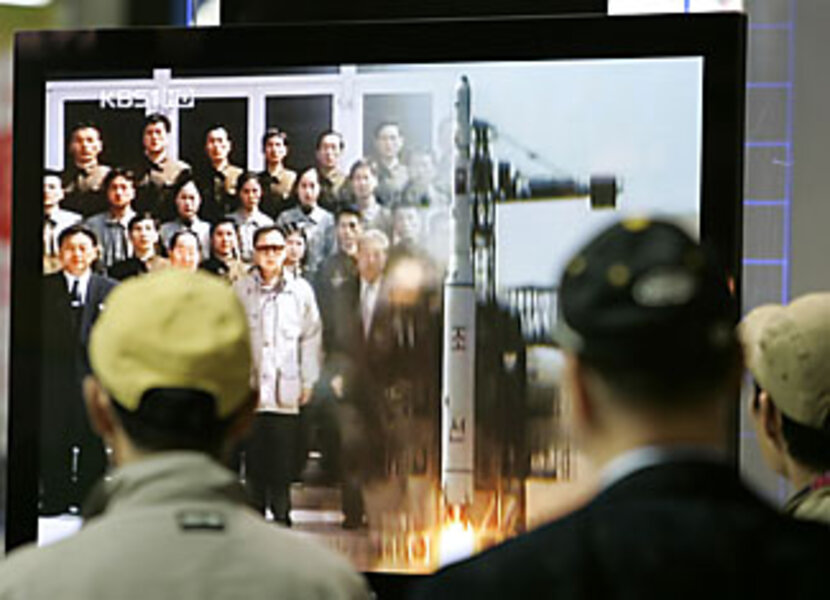North Korea used dummy satellite, South Korean experts say
| Seoul, South Korea
The satellite that North Korea insists it has sent into orbit was evidently a dummy that the North manufactured to justify testing a Taepodong-2 missile, South Korean space experts say.
The apparent use of a dummy that looked like a satellite on the launch pad boosts US, Japanese, and South Korean claims that the North fired its long-range missile on Sunday to continue developing the technology rather than to pursue space exploration.
Disagreement over North Korea's motivation is one issue blocking the UN from issuing a resolution on Sunday's launch. China, which wields veto power on the UN Security Council, says it's still unclear if North Korea launched a missile or a satellite.
Scientists and engineers here disagree. "They cannot have been shooting a real satellite," says Myung Noh-hoon, director of the Space Research Center at the Korea Advanced Institute of Science and Technology, the country's leading base for science and engineering. "They did not build a satellite."
Mr. Myung, in charge of development of South Korea's satellites in his facility in the city of Daejeon, about 90 miles south of here, bases that assessment on two realities.
First, he says, in the two days since the missile was launched, we have been "trying to catch the signal from the satellite." That was not possible, he says, "because it was a dummy, not a real one."
Second, he adds, while North Korean scientists and engineers are known to have built several hundred short- and mid-range missiles as well as nuclear warheads, there's never been any sign of fabrication of a satellite.
"I never heard of them building a satellite," says Myung. "Their level of satellite technology is lower than South Korea's." Six South Korean satellites have gone into space successfully from launch sites in other countries. In July Seoul plans to launch a 100-kilogram (220-pound) satellite – its first from South Korean soil.
The Taepodong-2 launched Sunday landed in the Pacific Ocean along with its original payload. The US North American Aerospace Defense Command reported shortly afterward that a satellite had failed to go into orbit.
No UN violation, North Korea insists
North Korea, meanwhile, insists that the launch was meant for space exploration and therefore did not violate UN Security Council resolutions adopted in 2006 banning North Korea from conducting nuclear tests or developing and launching missiles capable of delivering warheads.
The Security Council acted after North Korea, on July 5, 2006, fired an earlier version of the Taepodong-2, which fell into the sea 40 seconds after launch, and then, on Oct. 9, 2006, conducted an underground nuclear test.
South Korean scientists agree that, whatever North Korea had on the tip of the Taepodong-2, there was never any chance it would go into space.
"The launch was successful," says Lee Dok-joo, professor of aerospace engineering at the Korea Advanced Institute of Science and Technology, widely known as KAIST, "but the satellite was intentionally discarded." Normally, he adds, "a satellite has a signal, but we have no capability to detect this one."
Both Myung and Mr. Lee are involved in South Korea's plan to launch a satellite from a site near the South's southern coast in July.
Lee estimates the cost of a satellite at $100 million, in addition to between $200 million and $300 million for the rockets or missiles needed to send it into space. "There is some mystery" about the North Korean launch, he says, but believes "they built a dummy to save money."
Similarities with earlier missile test
Another factor adding to the conclusion that North Korea never had a satellite was the similarity between the latest episode and the launch on Aug. 31, 1998, of Taepodong-1, which also flew over Japan before landing in the Pacific. Then, as on Sunday, North Korea said the satellite went into space broadcasting patriotic paeans to North Korean leader Kim Jong Il and his father, Kim Il Sung, who died in 1994 but holds the title of "eternal president."
Scientists do not understand how North Korea could fail in such costly attempts if they ever intended to loft satellites in the first place. North Korea is believed to have obtained the technology from Iran, which has shot its own satellite into space.
Myung believes, though, that North Korea can count the launch as a success. "They shot a long-range missile farther than ever before," he says. This one went approximately 2,000 miles, twice the distance of Taepodong-1 and nearly half the distance needed to deliver a warhead to Alaska or Hawaii.
As for ever finding the debris from whatever North Korea had as the payload on the latest launch, "it may have been burnt up while returning to the Earth," says Kim Tae-woo, vice president of the Korea Institute for Defense Analyses.
"As far as I know, their satellite technology is very outdated," says Mr. Kim. "They have tried to advance ballistic missile technology. They do not care about satellites."





